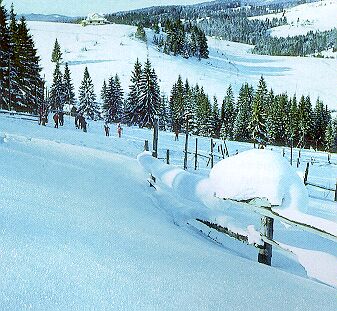Geology and geomorphology
![]()
 The Ukrainian
part of the Eastern Carpathians, like the whole Carpathian arch, is attributed to the
Alpine geosynclinal belt. The mountains form part of the northern branch of the Alpine
folded region. The composite folded-cover structures, which form the mountains, have
appeared, mainly, as a result of the Cainozoic (Alpine) folding. There are two main
tectonic zones in the Carpathians - the External flysch Carpathians and the Internal
lime-crystalline-volcanic Carpathians, edged with the Pre-Carpathian marginal trough and
Transcarpathian internal trough. The Ukrainian Carpathians - are mainly the External
Carpathians, since the second zone is deeply descended and concealed under the neogene
sediments. Some native geomorphologists refer to the Internal Carpathians, within the
whole territory of Ukraine, only the Marmaroska zone. The natural boundary-line between
the External Carpathians and Transcarpathian trough is the Pennine zone. In geological
structure of the territory prevail the layers of lime and palaeogene flysch - sandstones,
siltstones and mudstones; here and there, occur the outlets of the Jurassic limestones
(Pennine or Strimchakova /Cliff/ zone) and palaeozoic crystalline schists (Marmaroska
zone). The volcanogenic formations are represented by andesites, basalts and tuffs (the
Volcanic Carpathians).
The Ukrainian
part of the Eastern Carpathians, like the whole Carpathian arch, is attributed to the
Alpine geosynclinal belt. The mountains form part of the northern branch of the Alpine
folded region. The composite folded-cover structures, which form the mountains, have
appeared, mainly, as a result of the Cainozoic (Alpine) folding. There are two main
tectonic zones in the Carpathians - the External flysch Carpathians and the Internal
lime-crystalline-volcanic Carpathians, edged with the Pre-Carpathian marginal trough and
Transcarpathian internal trough. The Ukrainian Carpathians - are mainly the External
Carpathians, since the second zone is deeply descended and concealed under the neogene
sediments. Some native geomorphologists refer to the Internal Carpathians, within the
whole territory of Ukraine, only the Marmaroska zone. The natural boundary-line between
the External Carpathians and Transcarpathian trough is the Pennine zone. In geological
structure of the territory prevail the layers of lime and palaeogene flysch - sandstones,
siltstones and mudstones; here and there, occur the outlets of the Jurassic limestones
(Pennine or Strimchakova /Cliff/ zone) and palaeozoic crystalline schists (Marmaroska
zone). The volcanogenic formations are represented by andesites, basalts and tuffs (the
Volcanic Carpathians).
The Ukrainian Carpathians are middle altitudinal mountains, and do not reach the snow-line. The most raised parts of the summit's cover are typical for Chornohora (2061 m), Marmaroskiy crystalline massif (1946 m), Svydovets (1883 m), Horhany (1836 m). The present-day relief was formed owing to the uneven latest raises (in Pliocene - Quarternary Age) and the erosional breaking up. The smaller resistance of the flysch rocks against denudation - the reason of typical for the Carpathians smoothed relief forms. The hardness and durability of the crystalline rocks of the Marmaroskiy massif have determined the strongly breaked up relief of this territory with the deep gorges, sharp ridges and summits. The traces of pleistocene icing - kars, glacial cirques, trough valleys and moraine are represented in Chornohora, Svydovets and Marmarosh. The Pennine zone is characterized by numerous rocky outlets of limestones and dolomites of the Trias, Jurassic and Lower Cretaceous Ages in a form of isolated cliffs. The karst phenomena is well marked in this zone, especially its underground forms - caves, pits, grottos.
The Carpathian biosphere reserve is located on the south-western megaslope of the Eastern Carpathians' Ukrainian segment. Most of the protected massifs are located in the folded region, mainly in zone of the External (flysch) Carpathians (Chornohirskiy, Svydovetskiy, partly Uholsko-Shyrokoluzhanskiy protected massifs, regional landscape park "Stuzhytsa"), and also in Marmaroska zone (Maramoroskiy and Kuziyskiy massifs) and zone of the Pennine cliffs (southern part of Uholsko-Shyrokoluzhanskiy massif). Only the "Valley of Narcissi" massif and botanical preserves "Chorna Hora" and "Yulivska Hora" are located outside the zone of the folded Carpathians - in the region of Transcarpathian internal trough (Khustsko-Solotvynska hollow and the Volcanic Carpathians).